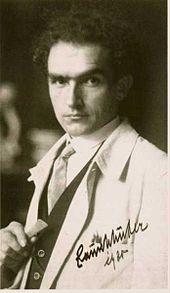Luis Rauschhuber
Luis Rauschhuber (born May 31, 1904 in Munich ; † May 7, 1973 in Nuremberg ) was a German sculptor .
Rauschhuber lived and worked most of his life in Nuremberg . There he first found work with a stonemason , attended evening courses in drawing and was accepted into the school of applied arts. He attended the Academy of Fine Arts in Munich for three years and then settled in Nuremberg as a freelance sculptor.
Luis Rauschhuber was a visionary loner. He was by nature deeply religious. He viewed a successful job as a “grace”, a gift from God. His artistic work always came first for him, he understood this as his mission.
biography
Luis Rauschhuber spent his tough childhood in Upper Bavaria. Even as a teenager, he was an orphan, he earned his own living and worked building canals on the Inn. In 1924 Rauschhuber came to Nuremberg, where he discovered his love for architecture and sculpture. He decided to do an apprenticeship as a stonemason. At the same time he took evening courses in drawing at the Nuremberg School of Applied Arts (then " State School for Applied Arts "). Due to his obvious talent, he was accepted into this school and received several prizes and awards for his work.

From 1930 to 1933 a scholarship enabled him to study at the Academy of Fine Arts in Munich with Karl Killer . His recording work, The Man of Sorrows , is today in the Church of St. Martin as a war memorial. In 1933 he returned to Nuremberg and from then on worked as a freelance sculptor. Mostly with his portraits he soon gained public attention and received private and public commissions. He participated in many exhibitions. He was never actually drafted into military service during World War II. His studio was completely destroyed twice and he also lost his apartment.
In 1944 he married Gertrud Meixner, with whom he lived in Würzburg until the end of the war. Returning to Nuremberg in 1947, he was in lively exchange with other artists: painters, architects, musicians, poets and people from the theater. He had a special friendship with the painter Eitel Klein . He was a co-founder of the artist group Der Kreis , from which he withdrew after a few years. He worked unimpressed by the change in art that took place in the 1960s / 70s and remained true to his style and beliefs. The development of his artistic creation took place independently of fashion and external trends. He created his last large-scale sculpture The Suffering Man in 1971. It is in the Nuremberg North Clinic .
Luis Rauschhuber died on May 7, 1973 at the age of almost 69 in Nuremberg.
A rich collection of Luis Rauschhuber's letters and writings can be found in the archive of the Germanic National Museum in Nuremberg.
Public contracts and larger works

- 1930: Man of Sorrows in the Church of St. Martin, Rollnerstrasse / Grolandstrasse in Nuremberg
- 1938: Portrait mask of Beethoven in the concert hall of the Nuremberg Academy of Music
- 1949: Balcony frieze in the meeting room of the town hall , Theresienstraße, Nuremberg
- 1952: Stone crucifix at the entrance to the Johannisfriedhof, Nuremberg
- 1954: Brother Konrad - side altar, in the Church of St. Ludwig, Straßburger Strasse, Nuremberg
- 1955: Sandstone relief in the courtyard of the South Tax Office, Sandstrasse, Nuremberg
- 1956: Stone sculpture The Holy Family in the atrium of the church Zur Hl. Familie Frau-Holle-Weg in Würzburg / Heidingsfeld
- 1957: Madonna made of stone, in the Church of St. Wolfgang , Friesenstrasse, Nuremberg
- 1957: Iron wall design at the vocational school in Gudrunstraße, Nuremberg
- 1958: Portrait busts of the founders of the Nuremberg Business School, Vershoven and Rieger, School of Business, Findelgasse, Nbg.
- 1959: Stations of the Cross in the Church of St. Georg , Bierweg, Nuremberg / Ziegelstein
- 1960: The unbelieving Thomas side altar, in the Church of St. Elisabeth , Josefsplatz, Nuremberg
- 1961: House sign at the University Women's Clinic, Universitätsstrasse, Erlangen
- 1962: stone sculpture music in front of the Hospital of the LVA, Herzoghöhe in Bayreuth
- 1963: Priest's grave in the Südfriedhof, Trierer Strasse, Nuremberg
- 1964: St. Sebastian in the Theresienkrankenhaus, Momsenstrasse, Nuremberg
- 1966: Madonna in St. Wunibald , Nuremberg, Saarbrückener Strasse
- 1966: House sign writers at the Nürnberger Nachrichten publishing house, Blumenstrasse, Nuremberg
- 1967: Madonna and Child in the Church of St. Martin, Rollnerstrasse / Grolandstrasse, Nuremberg
- 1967: Christ on the cross in the Josefskapelle , Nailastraße, Hof / Upper Franconia
- 1968: Madonna and Child in the Christ König Church, Josef-Fruth-Platz, Ansbach
- 1968: Madonna, altar design and triumphal cross, in the church of St. Heinrich , Eckbertstraße, Bamberg
- 1971: The suffering person in front of the Nuremberg North Clinic, Flurstrasse, Nuremberg
- 1972: Madonna light bearer in the Church of St. Jacobus , Quiddestrasse, Munich / Perlach
- 1972: Way of the Cross and Triumphal Cross, in the chapel of the Niederbronn Sisters of St. Georg, Nuremberg
Web links
Individual evidence
- ^ Portrait of `Wrage von Pustau, dancer ' , Luis Rauschhuber.
| personal data | |
|---|---|
| SURNAME | Rauschhuber, Luis |
| BRIEF DESCRIPTION | German sculptor |
| DATE OF BIRTH | May 31, 1904 |
| PLACE OF BIRTH | Munich |
| DATE OF DEATH | May 7th 1973 |
| Place of death | Nuremberg |
